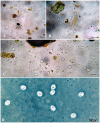Molecular characterization of Cryptosporidium spp. in dogs and cats in the city of Rio de Janeiro, Brazil, reveals potentially zoonotic species and genotype
- PMID: 34343188
- PMCID: PMC8330930
- DOI: 10.1371/journal.pone.0255087
Molecular characterization of Cryptosporidium spp. in dogs and cats in the city of Rio de Janeiro, Brazil, reveals potentially zoonotic species and genotype
Abstract
Intestinal cryptosporidiosis is a diarrheal disease caused by protists of genus Cryptosporidium that infect a wide variety of hosts, primarily vertebrates. Due to the close contact between humans and their companion animals, especially dogs and cats, there is concern about the potential for zoonotic transmission of this enteric protozoan parasite by infected animals. This study aimed to perform a microscopic and molecular diagnosis of Cryptosporidium spp. in fecal samples from domiciled dogs and cats. One hundred and nineteen fecal samples were processed using sugar centrifugal flotation followed by molecular detection of Cryptosporidium spp. DNA using nested PCR. Subtyping of isolates positive for C. parvum was performed by sequence analysis of the 60 kDa glycoprotein gene (GP60). Cryptosporidium oocysts were detected in 7.8% (5/64) and 5.4% (3/55) of the fecal samples from dogs and cats, respectively. Cryptosporidium canis (n = 3) and C. parvum (n = 2) were the main species found in dogs, whereas C. felis (n = 3) was prevalent in cats. Subtype IIaA17G2R2 (potentially zoonotic) was identified in samples positive for C. parvum. Despite the low prevalence of Cryptosporidium observed in the domiciled dogs and cats, the presence of potentially zoonotic C. parvum in dogs evidences a public health concern. Further research is needed to better understand the epidemiology, source, and potential impacts of Cryptosporidium infection in cats and dogs.
Conflict of interest statement
The authors have declared that no competing interests exist.
Figures



Similar articles
-
Detection and molecular diversity of Giardia duodenalis and Cryptosporidium spp. in sheltered dogs and cats in Northern Spain.Infect Genet Evol. 2017 Jun;50:62-69. doi: 10.1016/j.meegid.2017.02.013. Epub 2017 Feb 17. Infect Genet Evol. 2017. PMID: 28219812
-
Molecular detection of Cryptosporidium spp. and the occurrence of intestinal parasites in fecal samples of naturally infected dogs and cats.Parasitol Res. 2018 Sep;117(9):3033-3038. doi: 10.1007/s00436-018-5986-4. Epub 2018 Jun 29. Parasitol Res. 2018. PMID: 29959518
-
Seasonal distributions and other risk factors for Giardia duodenalis and Cryptosporidium spp. infections in dogs and cats in Chiang Mai, Thailand.Prev Vet Med. 2020 Jan;174:104820. doi: 10.1016/j.prevetmed.2019.104820. Epub 2019 Nov 4. Prev Vet Med. 2020. PMID: 31739222
-
Advances in molecular epidemiology of cryptosporidiosis in dogs and cats.Int J Parasitol. 2021 Sep;51(10):787-795. doi: 10.1016/j.ijpara.2021.03.002. Epub 2021 Apr 20. Int J Parasitol. 2021. PMID: 33848499 Review.
-
Occurrence of zoonotic enteric parasites in fecal samples from dogs in shelters, parks, squares and public roads, and the dog guardians' perception of zoonoses as for the risk to public health in the city of Guarapuava, Paraná, Brazil.Top Companion Anim Med. 2024 Jan-Feb;58:100826. doi: 10.1016/j.tcam.2023.100826. Epub 2023 Oct 24. Top Companion Anim Med. 2024. PMID: 37884174 Review.
Cited by
-
Molecular diagnosis of intestinal protozoa in young adults and their pets in Colombia, South America.PLoS One. 2023 May 23;18(5):e0283824. doi: 10.1371/journal.pone.0283824. eCollection 2023. PLoS One. 2023. PMID: 37220135 Free PMC article.
-
Cryptosporidium and Giardia in cats and dogs: What is the real zoonotic risk?Curr Res Parasitol Vector Borne Dis. 2023 Nov 30;4:100158. doi: 10.1016/j.crpvbd.2023.100158. eCollection 2023. Curr Res Parasitol Vector Borne Dis. 2023. PMID: 38089689 Free PMC article. Review.
-
The prevalence of potentially zoonotic intestinal parasites in dogs and cats in Moscow, Russia.Helminthologia. 2023 Jun 4;60(1):44-51. doi: 10.2478/helm-2023-0009. eCollection 2023 Mar. Helminthologia. 2023. PMID: 37305673 Free PMC article.
-
Evidence of the Zoonotic Transmission of Cryptosporidium among Children and Pets.Pathogens. 2023 Nov 27;12(12):1393. doi: 10.3390/pathogens12121393. Pathogens. 2023. PMID: 38133278 Free PMC article.
-
Molecular prevalence and subtyping of Cryptosporidium spp. in fecal samples collected from stray cats in İzmir, Turkey.BMC Vet Res. 2022 Mar 7;18(1):89. doi: 10.1186/s12917-022-03190-y. BMC Vet Res. 2022. PMID: 35255909 Free PMC article.
References
-
- Wells DL. The effects of animals on human health and well-being. J. Soc. 2009; 65:523–543. 10.1111/j.1540-4560.2009.01612.x - DOI
-
- Abinpet. 2015. Faturamento do setor crescerá 7,4% e fechará em R$ 17,9 bilhões em 2015. Disponível em: <http://pabinpet.org.br/site/faturamento-do-setor-crescera-74-e-fechara-e...>. Accessed June 08, 2019.
-
- Fayer R, Xiao L (eds). Cryptosporidium and Cryptosporidiosis. Boca Raton, London, New York: Taylor and Francis Group, CRC Press, 2007, 564p.
MeSH terms
LinkOut - more resources
Full Text Sources
Medical
Miscellaneous

